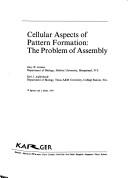Monographs in Developmental Biology
1 primary work
Book 22
Cellular Aspects of Pattern Formation: The Problem of Assembly
by G. W. Grimes and K. J. Aufderheide
Published 18 July 1991
DNA as "the molecule of life" has long been considered the only source of information on the molecular organization of cell components, and the process of self-assembly has been used to explain their structural diversity. Refuting this widely-held view, the authors of this book advance the argument that the existing molecular components of the cell have a profound influence on the assembly of new structures during morphogenesis in a more important complementary process, termed "directed assembly", which operates at post-translational levels of gene expression. Following a broad account of the concept of directed assembly based on studies of ciliate protozoa, the authors apply the concept to the interpretation of patterning phenomena in multicellular developing systems, and demonstrate its universal significance to pattern formation in eukaryotic cells. Furthermore, a speculation is presented that prion particles, apparently the causative agents of certain neuro-degenerative diseases, may be able to reproduce themselves by a form of directed assembly.
